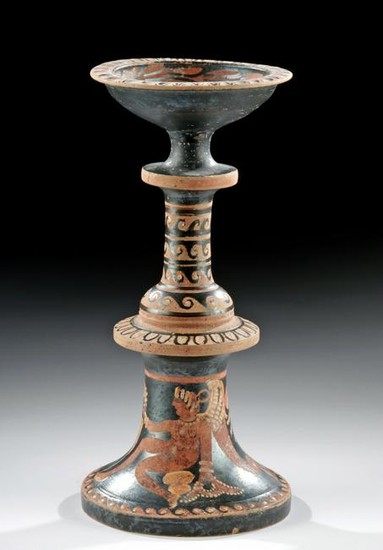Greek Paestan Red-Figure Thymiaterion, TL Tested
Magna Graecia, South Italy, Paestan, ca. 4th to 3rd century BCE. A stunning terracotta thymiaterion (incense burner) decorated via the red-figure technique w/ fugitive white and yellow pigments. Adorning the base is a winged Erote sitting upon a rocky outcrop and holding a tambour in the raised hand an another wreath-like attribute in the lowered hand. On the opposite side is an elegant stylized palmette. Underscoring these elements is a band of continuous wave motifs. The central tier of the thymiaterion features a band of tongues followed by four wave bands. Finally, the footed bowl/receptacle above presents a band of tongue motifs on the rim, a laurel leaf garland bordering the bowl and surrounding a three-legged triskelion motif in the tondo. An impressive example replete with an elaborate decorative program and an elegant form. Size: 4.125" in diameter at base x 8.25" H (10.5 cm x 21 cm)
Thymiateria (derived from a Greek word meaning "to smoke") were ancient censers or incense burners used for religious or spiritual purposes such as sacrifices or offerings to the deities. Although the term originated for ancient Greek forms, it is also used for censers created by other ancient peoples such as the Etruscans and the Phoenicians. Interestingly, thymiateria are still used today in Greek Orthodox churches.
This piece has been tested using thermoluminescence (TL) analysis and has been found to be ancient and of the period stated. A full report will accompany purchase.
Provenance: private J.H. collection, Beaverton, Oregon, USA, acquired in August 2001; ex-Tom Cederlind collection, Portland, Oregon, USA
All items legal to buy/sell under U.S. Statute covering cultural patrimony Code 2600, CHAPTER 14, and are guaranteed to be as described or your money back.
A Certificate of Authenticity will accompany all winning bids.
We ship worldwide to most countries and handle all shipping in-house for your convenience.
#149627
Condition Report: There is a TL hole in the base and one to the underside of the upper footed bowl. Minute nicks/chips to rim of bowl with possible inpainting to decoration around the rim. Nicks to periphery of the base. Pressure fissures to bowl. Normal surface wear with scuffs and minute pigment loss. Scattered deposits most visible on buff clay on exterior and interior/underside but also visible on the Erote, palmette, and other decorative motifs. Black glaze has developed a gorgeous iridescence.
View it on
Sale price
Estimate
Time, Location
Auction House
Magna Graecia, South Italy, Paestan, ca. 4th to 3rd century BCE. A stunning terracotta thymiaterion (incense burner) decorated via the red-figure technique w/ fugitive white and yellow pigments. Adorning the base is a winged Erote sitting upon a rocky outcrop and holding a tambour in the raised hand an another wreath-like attribute in the lowered hand. On the opposite side is an elegant stylized palmette. Underscoring these elements is a band of continuous wave motifs. The central tier of the thymiaterion features a band of tongues followed by four wave bands. Finally, the footed bowl/receptacle above presents a band of tongue motifs on the rim, a laurel leaf garland bordering the bowl and surrounding a three-legged triskelion motif in the tondo. An impressive example replete with an elaborate decorative program and an elegant form. Size: 4.125" in diameter at base x 8.25" H (10.5 cm x 21 cm)
Thymiateria (derived from a Greek word meaning "to smoke") were ancient censers or incense burners used for religious or spiritual purposes such as sacrifices or offerings to the deities. Although the term originated for ancient Greek forms, it is also used for censers created by other ancient peoples such as the Etruscans and the Phoenicians. Interestingly, thymiateria are still used today in Greek Orthodox churches.
This piece has been tested using thermoluminescence (TL) analysis and has been found to be ancient and of the period stated. A full report will accompany purchase.
Provenance: private J.H. collection, Beaverton, Oregon, USA, acquired in August 2001; ex-Tom Cederlind collection, Portland, Oregon, USA
All items legal to buy/sell under U.S. Statute covering cultural patrimony Code 2600, CHAPTER 14, and are guaranteed to be as described or your money back.
A Certificate of Authenticity will accompany all winning bids.
We ship worldwide to most countries and handle all shipping in-house for your convenience.
#149627
Condition Report: There is a TL hole in the base and one to the underside of the upper footed bowl. Minute nicks/chips to rim of bowl with possible inpainting to decoration around the rim. Nicks to periphery of the base. Pressure fissures to bowl. Normal surface wear with scuffs and minute pigment loss. Scattered deposits most visible on buff clay on exterior and interior/underside but also visible on the Erote, palmette, and other decorative motifs. Black glaze has developed a gorgeous iridescence.



